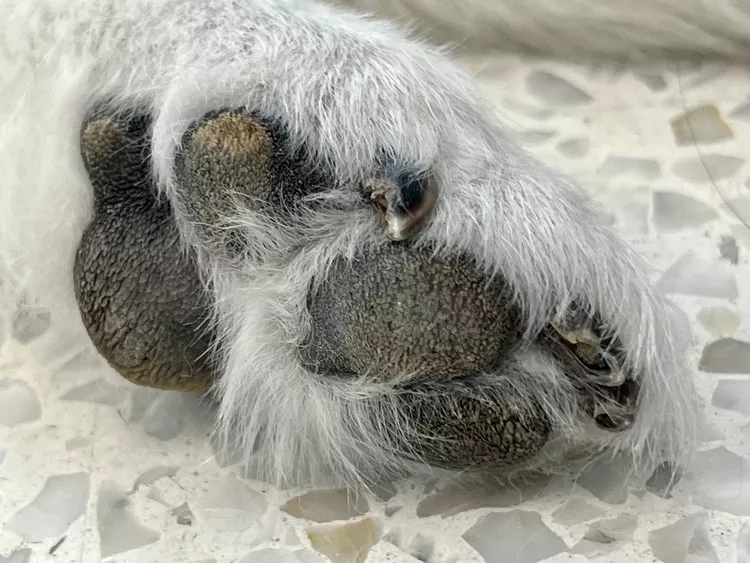JUMP TO 
Hyperkeratosis in Dogs
Hyperkeratosis is the result of an overgrowth of skin cells, called keratinocytes, in these areas that causes the skin to develop thick feathering or fronding. Sometimes the areas appear scaly as well


Hyperkeratosis in dogs generally affects the non-haired skin of the nose and paw pads. Hyperkeratosis is the result of an overgrowth of skin cells, called keratinocytes, in these areas that causes the skin to develop thick feathering or fronding. Sometimes the areas appear scaly as well. Hyperkeratosis can be caused by a variety of conditions, or it can occur without any discernible cause at all.
What Is Hyperkeratosis?
Hyperkeratosis is a condition in which keratinocytes, the skin cells that produce keratin, over multiply and fail to shed properly, resulting in overgrowth and thickening of skin tissue. Dog paw hyperkeratosis is the most common manifestation of this condition, as is hyperkeratosis of the nasal planum, or the pigmented, hairless portion of a dog’s nose. The condition may also occur in pressure point areas that are hairless, like elbows.
Keratin is a fibrous protein that serves an important function in the epidermis of animals and humans. The epidermis is the most superficial layer of tissue that makes up the skin. It provides a barrier between the body and the rest of the world, ensuring that moisture is kept in and harmful elements, like ultraviolet radiation and bacteria, are kept out.
Keratinocytes in the epidermis produce keratin, which protects and strengthens cells and helps prevent cell death and damage. Within the epidermis, layers of keratinocytes undergo a continuous process of growth, maturation, and death so that enough keratin is always present in the skin.1 When these cells die, they slough off along with other cells that make up the skin. Keratin is crucial for the formation of nails, horns, hooves, hair, beaks, and claws, but when something goes wrong with the life cycle of keratinocytes, it can become a problem for the animal.
Symptoms of Hyperkeratosis in Dogs
Rough, Thickened, Frond-like Skin Growth
The most obvious symptom that dogs with hyperkeratosis will show is a distinctive overgrowth of skin in areas like the paw pads, nose, and calluses on the elbows. Often, this overgrowth can be found at the outer margins of paw pads and the topmost part of the nose. The abnormal skin appears to have a frond-like or feathered shape and is thicker, harder, and drier than normal skin.
Cracks, Fissures, or Erosions
Hyperkeratotic skin is thicker and drier than normal skin, so it may be more prone to external trauma leading to cracking, fissuring, and eroding. As a result, the normal protective barrier of the skin is compromised and it is less effective at guarding against pathogens like bacteria. Secondary bacterial infections may set in. Because hyperkeratosis leads to abnormal, unbalanced skin growth, yeast and bacteria that normally would exist in small numbers on the skin and not cause a problem may also start to overmultiply, leading to a secondary
Pain and Difficulty Walking
If severe, the abnormal, proliferative tissue can cause pain and discomfort to dogs, particularly when it’s on dog paws. This can impair movement. The pressure of the overgrown, dry skin may also cause discomfort to the dog when the area is handled or pressure is applied. For example, severe hyperkeratosis that has cracked on pressure points on the elbows may cause a dog discomfort when trying to lie down.
Causes of Hyperkeratosis
Hyperkeratosis is most commonly caused by an inherited disorder or is idiopathic, meaning there is no identifiable cause, but trauma, infectious diseases, and immune-mediated diseases can also cause it. In most cases of otherwise healthy dogs, the cause is idiopathic. Some dog breeds develop specific hyperkeratotic conditions that are hereditary. Age-related changes are also a factor in this condition, since it is often seen in older dogs.
Nasodigital hyperkeratosis, or dog paw and nose hyperkeratosis, is an inherited or age-related disorder. It can occur in any dog breed, but is most common in cocker spaniels, basset hounds, beagles, boxers, and bulldogs. It is most often diagnosed in older dogs.2
Nasal parakeratosis is an inherited condition in Labrador retrievers that only affects the nose. Unlike nasodigital hyperkeratosis, this condition appears in Labrador retrievers at around 6-12 months of age and may come and go over time.3
When an area of the skin is repeatedly traumatized, the keratinocytes may respond by overproducing keratin. This can be seen in cases of hyperkeratosis at pressure points. For example, if a dog is frequently lying down on a hard floor without adequate bedding and develops pressure sores on the elbows, hyperkeratosis may manifest in the affected areas.
Hyperkeratosis can also occur from systemic infections like canine distemper virus and leishmaniasis, a protozoal infection spread by biting flies. Immune-mediated diseases, like systemic lupus erythematosus and pemphigus foliaceus, can also cause hyperkeratosis.
Zinc responsive dermatosis is another possible cause. There are two syndromes associated with this condition. Syndrome 1 develops in some Alaskan dog breeds like huskies or Malamutes who are unable to properly absorb zinc from their diets. Syndrome is seen in large and fast-growing dog breeds like Great Danes, when their diets include too much supplementation with minerals that bind zinc. Finally, dogs with zinc-deficient diets can also suffer from this condition.
Diagnosing Hyperkeratosis in Dogs
If an underlying cause is suspected, like an autoimmune disease or zinc responsive dermatosis, that must first be ruled out. Your veterinarian will conduct a complete physical examination and ask questions about your dog’s medical history, diet, and environment.
Diagnostics may include blood tests, both as a general baseline as well as specialized tests. Skin samples may be taken as well, including impressions or scrapings of the skin to determine if yeast and bacteria are present, and skin biopsies.
Treatment
In healthy dogs with inherited or idiopathic hyperkeratosis, any secondary bacterial or yeast infections must be treated. There is no cure for the hyperkeratosis, but it can be managed to keep your dog comfortable and pain-free. Treatment includes using ointments or balms to soften the dry, hard tissue and removal of excess tissue.3
Berger D. Nasal Planum Disease in Dogs. Clin Brief. June 2018;16(6):14-20.
If a systemic disease is identified as the cause of the hyperkeratosis, that condition would be addressed and treatment would depend on the specific condition. It may entail diet changes and supplementation if zinc-responsive dermatosis is diagnosed. Other conditions such as leishmaniasis and canine distemper virus have a poor prognosis and treatment depends on the disease, how sick the pet is, and may range from hospitalization to even humane euthanasia in some cases.
Immune-mediated conditions are treated with drugs that suppress the immune system as well as antibiotics and antifungals for secondary infections as needed. Generally, immune-suppressive drugs are given systemically, but sometimes topical drugs work as well.
